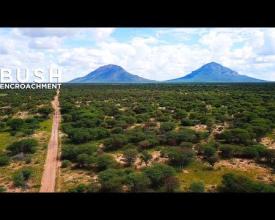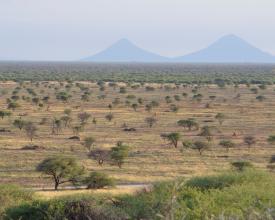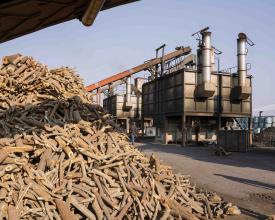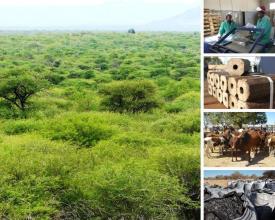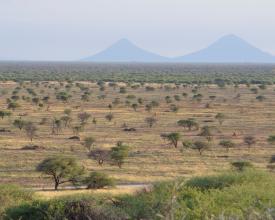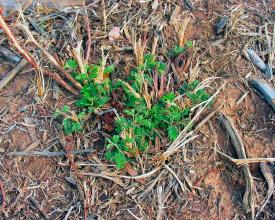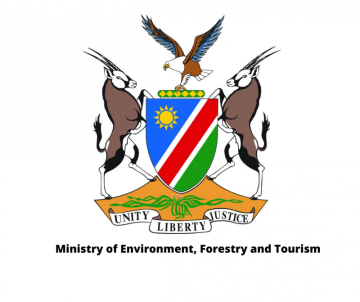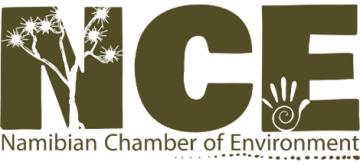
Namibian Bush Biomass: An Ecosystem Restoration Solution
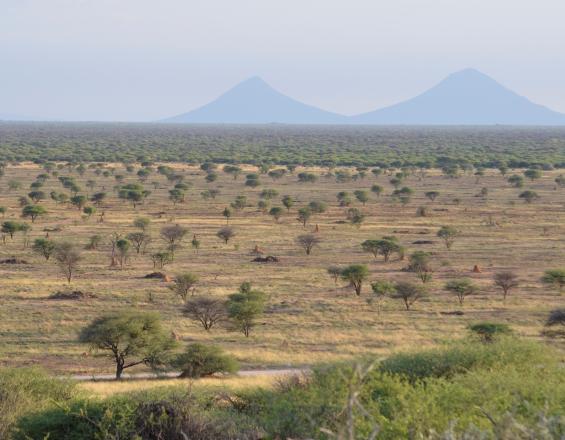
Namibia's savanna ecosystem witnesses the expansion and densification of shrubs, a phenomenon globally known as woody plant encroachment. This is attributed to various factors, including overgrazing, the exclusion of larger mammals and browsers, and wildfire suppression. Climate change is an accelerating factor, as atmospheric CO2 fosters woody vegetation growth.
Increasing shrub thickening leads to reduced land productivity, triggers a decline in biodiversity and hampers groundwater recharge. With already 45 million hectares of rangeland affected, this is literally a growing problem for rural communities.
Namibia strategically promotes value addition as an economic incentive for sustainable bush control. This includes energetic utilisation, biochar, animal fodder, and construction material. The Namibian biomass sector provides employment for 12,000 workers and allows farmers to diversify their income. The approach has become a pivotal in Namibia’s efforts of climate change adaptation and ecosystem restoration.
Contexto
Défis à relever
Environmental challenges
Bush encroachment, i.e. the excessive thickening of bush at the expense of grass on Namibian land, negatively impacts biodiversity and hampers groundwater recharge. It is a major cause for land degradation and accelerates the impacts of climate change.
Economic challenges
Bush encroached land bears a significantly lower agricultural productivity. The icome of farmers that predominantly depend on livestock or game farming diminishes. Agricultural productivity in Namibia has decreased by 2/3 over the past decades.
Ubicación
Procesar
Summary of the process
The building blocks constitute implementation steps of bush control and biomass utilisation. They are applicable to all bush control operations, although they must be prioritised and implemented according to the respective context conditions.
Building Blocks
Enabling Environment & Sector Coordination
Namibia prioritizes addressing bush encroachment, driven by the emergence of bush value chains. Localized farm-level measures yielded mixed results, necessitating a national framework: the National Strategy on the Sustainable Management of Bush Resources (2022-2027). This strategy aims to optimize bush resource utilization, safeguard sustainability, and benefit all Namibians while enhancing environmental outcomes.
Governance involves various sectors. Environmental and forestry sectors focus on land rehabilitation, sustainability, and management. Industrialization and trade support value chains. Agriculture seeks sustainable rangeland management to prevent encroachment.
Due to the cross-sectoral nature, a National Coordinating Body is crucial for collaboration, knowledge exchange, adaptive management, and informed decision-making.
Enabling factors
Key factors enabling guidance on bush control, a shared vision, and sustainable bush value chains include:
-
Stakeholders steering committee: A diverse committee provided policy direction and technical guidance, fostering cross-sectoral coordination and clear mandates.
-
Sector associations: Organizations like the Charcoal Association of Namibia (CAoN) and Namibia Biomass Industry Group (N-BiG) support policy advocacy, research, investments, and market development.
-
Policy harmonization locally and globally:
Lesson learned
Active work in the biomass sector by multiple stakeholder kick-started the discourse on the potential of biomass and has influenced the investigation into the formulation of new policies. The following lessons are learnt:
- Time: The process of facilitating discussion aimed at formulating policies and enabling framework shifts takes time. Buy-in for the necessary policy changes challenging and will be a much longer process, to secure higher-level commitment. Consistency is required in collecting information for policy makers, open stakeholder engagements and collaboration with the policymakers, academia and subject experts.
- Lack of public budget: minimal to lack of government budget dedicated to addressing bush encroachment led to limited commitment to key strategic decisions.
Status Quo Assessment and Management Plan
add
Enabling factors
add
Lesson learned
add
Identification of Value Addition Opportunities
The goal of bush control is savanna ecosystem rehabilitation, fostering biodiversity and balanced habitats with woody species and grasses. Bush value chains have emerged as a solution, turning a rehabilitation byproduct into an economic opportunity, prioritizing landscape diversity and large tree preservation to enhance natural controls.
Opportunities for value addition range from low-tech, labor-intensive to high-tech, capital-intensive products. The choice depends on factors like available resources, land rights, location, capital, expertise, market access, and local conditions.
The heart of value addition is the selection of bush control or harvesting methods. This pivotal decision marks the start of potential value chains. Multiple methods exist, varying in efficiency, effectiveness, and environmental sustainability, including large-scale mechanical control, heavily mechanized control, manual and semi-mechanized control, and chemical control.
Enabling factors
Farmers and companies enter the growing bush biomass sector. Current value chains involve global charcoal, local firewood, and small-scale production. The sector optimizes, diversifies, and scales. Key catalysts:
-
Financial Resources: Opportunities align with available finances.
-
Skilled Labor: Skilled workers ensure sustainability and efficiency.
-
Technical Equipment: Specialized gear handles hard wood and minerals
Lesson learned
Developing bush-based industries in Namibia is vital for financing sustainable bush thinning efforts. Abundant biomass offers economic opportunities:
- Customization for Local Context: International tech must align with local conditions.
- Co-financing in Low-Income Areas: Subsidies promote participation.
- SME Outsourcing for Cost Efficiency: SMEs cut costs for landowners.
- Cooperation & Knowledge Exchange: Sector bodies like Namibian Biomass Industry Group and Charcoal Association enhance innovation.
Namibia's robust bush-based industry restores ecosystems and fosters sustainable financing. Biomass abundance fuels diverse, optimized value chains. With catalysts and lessons, Namibia creates a valuable, sustainable "restoration economy" pooling private sector resources per ecological restoration principles and economic opportunities.
Resources
Continuous Aftercare
The removal of some or all of the woody plants creates a vacuum that will invariably be re-populated by woody plants, sometimes by more aggressive species. Natural defences against this phenomenon include a healthy and strongly competitive grass layer, and large bushes that are able to suppress the re-establishment and survival of new bush seedlings.
Despite these natural allies in the fight against re-infestation of aggressive woody species, an aftercare programme is absolutely essential to keep a thinned area open. This can be done in several ways such as mechanical slashing of new seedlings, localised (selective) chemical treatments of new growth, or even applying less popular management options such as controlled burning in combination with browsers. An efficient grazing management system that will ensure the maintenance of a healthy grass layer is also essential.
The most important aspect of an aftercare programme is that it should not be viewed as a once-off operation, but should become a permanent component of the day-to-day management of the farm.
Enabling factors
- Knowledge of the importance of aftercare and appropriate methodologies
- Documented best practices, showing the long-term affect of aftercare as compared to no aftercare
- Financial means for aftercare activities
Lesson learned
- Aftercare is often not implemented, since the there is little awareness of the negative consequences that occur when no aftercare is implemented
- Bush control and aftercare are a continuous process, not a once-off intervention
Impacts
By 2022, Namibia had certified 1.6 million hectares of encroached land via the Forest Stewardship Council (FSC), validating sustainable bush harvesting practices. Environmental effects are context-dependent and include:
- Increased plant biodiversity: less dominant woody plants, allowing diverse grasses and shrubs to recover
- Enhanced habitat for domestic and wild animals: increased land capacity, opening previously closed areas
- Improved groundwater recharge: with reduced canopy cover, evapotranspiration is reduced and more rainwater enters the ground
- Soil health: soil properties improve and the nutrient cycle remains uninterrupted when bush is turned into biochar and applied locally to cropland, vegetable gardens or rangeland
Depending on the site-specific bush density and the calculated sustainable extraction rate for bush thinning varies, with an average 10 tons per hectare. The utilisation of the biomass bears socio-economic benefits:
- Diversification of income for farmers, e.g. through the marketing of locally produced charcoal
- Enhanced drought resilience, e.g. through the production of bush-based animal fodder
- Job creation, employing 12,000 workers in harvesting and processing, with a significant share of women in processing
- Macroeconomic benefits, like export revenue and import substitution. Biomass exports, particularly charcoal, rank as the second largest export from the agricultural sector
Beneficiaries
- Land owners on communal and commercial land, i.e. commercial and export oriented farmers, emerging commercial farmers as well as subsistance farmers
- SMEs offering bush control services
- Workers, both unskilled labour and machine operators
Sustainable Development Goals
Story
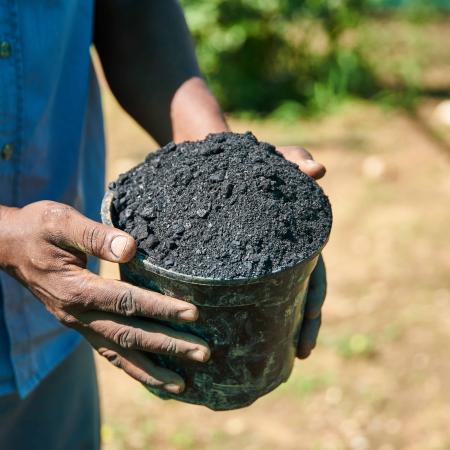
Biochar is the new innovation; it shows great potential for a myriad of applications and contributions to climate change adaptation.
Prime Biochar is made from encroacher bush species using the twigs and small branches. A first of its kind in Namibia by Sakeus Kafula, the product can be used to improve the quality of soils for centuries to come.
Sakeus grew up watching common agricultural practices result in land degradation. This is what drove his passion for soil health and restoration. “I saw from a young age how our practices were degrading the environment, and I knew this was what I needed to do - to be in a space that can help rectify some of these things. People see yields going down or longer dry spells, and they think it is just the norm, but this is where biochar comes into play. It can help your crop survive these dry spells, notes Sakeus, who adds that the benefits of biochar are not only available to crop farmers. Biochar can also be safely added to livestock licks and feeds, and in doing this, animals are more easily able to utilise and digest poor-quality feed.”
Full story: https://www.n-big.org/gains-for-generations-with-biochar/
Video: Gains for Generations with Prime Biochar - YouTube
